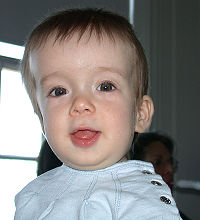
Photo from wikipedia
BACKGROUND Craniosynostosis is a rare congenital disease of the skull. They arise when one or more cranial sutures ossify prematurely. This causes an obstruction to normal brain growth and leads… Click to show full abstract
BACKGROUND Craniosynostosis is a rare congenital disease of the skull. They arise when one or more cranial sutures ossify prematurely. This causes an obstruction to normal brain growth and leads to specific deformations of the skull, which may result in intracranial hypertension and cognitive delay. MATERIALS AND METHODS We have retrospectively analysed all children treated at the Unit of paediatric neurosurgery of the University Medical Centre Ljubljana between June 2015 and September 2020. The following items have been recorded: affected suture, underlying syndromic condition, hydrocephalus, Chiari malformation, raised intracranial pressure, age at surgery, surgical technique, need for multiple operations and surgical complications. RESULTS During the study period, 71 children have been treated for craniosynostosis. The median postoperative follow-up was 31 months. There were: 54.9% sagittal, 25.3% metopic, 14.0% unicoronal, 1.4% bicoronal and 1.4% unilateral lambdoid craniosynostosis. Multiple sutures were affected in 2.8% cases. 7.0% of the cases were syndromic. Overall, 74 surgical procedures have been performed: frontoorbital advancement represented 40.5% of them; biparietal remodelling 32.4%: total cranial vault remodelling 22.9%; posterior distraction 2.7%; posterior expansion 1.3%. Median age at surgery was 12.8 months. CONCLUSIONS The treatment of craniosynostosis is surgical and requires a multidisciplinary approach, with expertise in plastic and reconstructive surgery, maxillofacial surgery and neurosurgery. The aim of surgical treatment is to release the constrictive and deformative effect that the synostosis has on skull growth. This requires a remodelling of the neurocranium and, if necessary, of the viscerocranium. Beyond aesthetic purposes, the primary aim of surgical treatment is to permit a normal development of the brain.
Journal Title: Journal of integrative neuroscience
Year Published: 2022
Link to full text (if available)
Share on Social Media: Sign Up to like & get
recommendations!